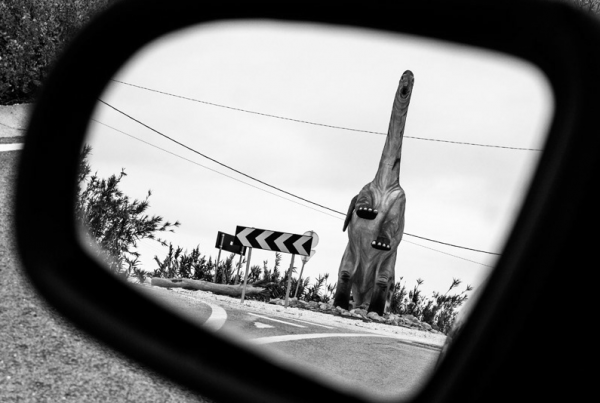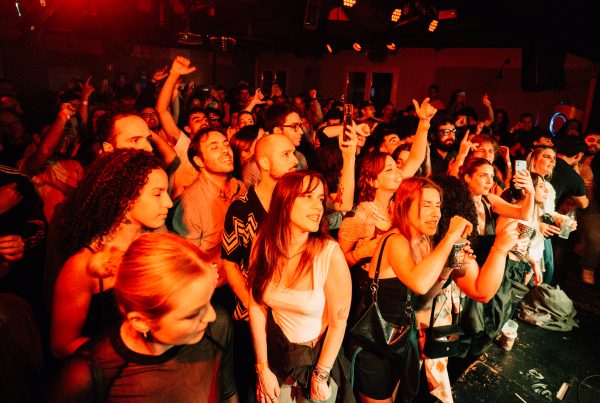
Sydney Baloue (@SydneyBaloue) is a writer and performer. In addition to working on a book chronicling the history and evolution of New York City’s ballroom scene, he is currently working as a consulting producer on Legendary, HBO Max’s new show about the ballroom scene.
Lembro-me da primeira vez que entrei na categoria “Butch Realness” no “Back to School Ball” em Paris, em 2014. Era a primeira vez que, como lésbica butch, existia uma categoria específica para mim na cena ballroom europeia. Tinha de dar uma de “racail”, um epíteto francês para os rapazes adolescentes franceses negros e do norte de África das classes baixas dos subúrbios de Paris. Estava vestido com umas calças de fato de treino cinzentas, sapatilhas Adidas pretas, meias brancas de cano alto puxadas até acima dos tornozelos e com a minha sweatshirt da Universidade da Pensilvânia. Quando o apresentador anunciou a categoria, eu estava no final da passarela com os nervos à flor da pele e com o capuz na cabeça, a aguardar o meu momento. Conseguia sentir a adrenalina a correr-me nas veias quando o apresentador perguntou “alguém a desfilar? 10, 9, 8…”. A mother da minha house, Marina UltraOmni, disse-me para esperar até chegar a meio da passarela para tirar o capuz e mostrar a minha cara. Pouco depois, à medida que segurava no capuz e o deslizava lentamente para trás, lembro-me da energia electrizante das pessoas que gritavam por mim. Isto durou 15 segundos, mas pareceu uma vida inteira. Os júris mostraram imediatamente as pontuações: só 10 do princípio ao fim! Passei num teste que foi maior do que o ball ou do que aquele momento; foi uma prova de quem eu realmente era.
Associar-me à diáspora da cultura ballroom na Europa foi uma forma de voltar a casa e à minha própria cultura, enquanto homem norte-americano transgénero e negro. Comecei a participar em balls em Berlim, onde fui bolseiro, e, mais tarde, entrei nos circuitos de Paris, Amesterdão, Londres e Nova Iorque. Para mim, o ballroom é mais do que uma moda passageira. É uma herança e uma cultura enraizadas na experiência LGBTQ americana, especificamente a negra e latina.
Com raízes nos balls drag do Harlem Renaissance, a versão actual do ballroom cristalizou-se no início da década de 70 em Nova Iorque, com o aparecimento da House of LaBeija em 1972. No final dos anos 80 e princípio dos 90s, graças a uma enorme onda de visibilidade, o ballroom chegou ao mainstream. A canção Deep in Vogue (1989), de Malcolm McLaren, contou com performers míticos como Aldawna Field, Adrian Magnifique e o ícone pioneiro Willi Ninja, que estavam na linha da frente da popularização do ballroom e do voguing. Mais tarde, o hit de Madonna, Vogue (1990), levou a cultura para outras dimensões, com os ícones do voguing Jose Xtravaganza e Luis Xtravaganza a ensinarem Madonna como “fazer pose” [“strike a pose”]. Jennie Livingston cimentou a tendência com o documentário Paris is Burning (1991), que captou um retrato da comunidade e funcionou como um manual didáctico para quem não estava dentro deste circuito. Actualmente, programas de televisão como Pose e My House, bem como a proliferação global do ballroom, abriram novas portas de formas inesperadas.
Esta expansão mundial é uma espécie de movimento descolonizador, à medida que as pessoas marginalizadas continuam a aceder à cultura ballroom através do YouTube, através de um contexto mais acessível para viajar e através das redes sociais. Comovi-me com as histórias das pessoas LGBTQ da etnia māori, na Nova Zelândia, que criaram a sua própria cena ballroom. Vi, nas suas lutas, semelhanças com as de pessoas não brancas queer e trans nos EUA, que também resistiram contra décadas de colonização e opressões interseccionais através do vogue e do ballroom.
É incrível ver a cultura ballroom a unir pessoas e a permitir que grupos oprimidos se celebrem a si próprios. Também é entusiasmante perceber que os membros da comunidade de Nova Iorque, e de outros pontos do mundo, estão a conseguir ter acesso a benefícios reais, materiais, com o interesse renovado na cultura. Embora seja empolgante o ballroom estar no centro das atenções, é fundamental proteger a integridade da cultura e a sua história, pois ambas podem ser descontextualizadas e apropriadas indevidamente, e a natureza espectacular da estética e da dança pode ofuscar o labor intenso e o significado mais profundo que estão por trás deste trabalho. Da mesma forma que é necessário trazer mais vozes para a mesa. Por exemplo, lésbicas butch e femme, mulheres cisgénero hetero e bissexuais e homens trans têm de ser reinscritos na narrativa da história do ballroom, pois também eles moldaram e redefiniram a cultura e a comunidade.
Numa altura em que vários países regressam a políticas conservadoras e opressoras, a explosão do ballroom, do voguing e de outras estéticas e atitudes relacionadas funciona como um acto de resistência e uma forma de sobrevivência para muitos. Estou muito grato por fazer parte desta cultura, e por ter tantos novos irmãos e irmãs em todo o mundo para partilharem este momento comigo.
/ Tradução por Linda Formiga
English Version
Ballroom culture, diaspora and me
I remember the first time I walked “Butch Realness” at the “Back to School Ball” in Paris in 2014. It was the first time a category was specifically for me as a butch lesbian in the European ballroom scene. I had to bring it like a “racail”, which is the French epithet for working class Black and North African-French male teenagers who live in Parisian suburbs. My look included gray boxing joggers, black Adidas sneakers with white tube socks pulled up past my ankles and my University of Pennsylvania sweatshirt. As the commentator called out the category, I nervously stood at the end of the runway with my hood pulled up, waiting for my moment. I could feel the energy race through my veins as I heard the commentator call out “anybody walking? 10, 9, 8…”. My house mother, Marina UltraOmni, told me to wait until I got to the middle of the runway before I pulled my hood off to reveal my face. Moments later as I gripped my hood, slowly pulling it back, I remember the electric energy of the crowd going wild for me. The moment lasted for 15 seconds, but felt like a lifetime. The judges immediately put up their scores, all tens across the board! I passed a test that was greater than the ball or this moment, it was a testament to my own authentic self.
Connecting with the diaspora of ballroom culture in Europe was a way for me to come home to myself and to my culture as a black transgender US American man. I first started walking balls in Berlin whilst on a fellowship and later joined the scene in Paris, Amsterdam, London and New York City. For me, ballroom is beyond a passing fad. It’s about a heritage and a culture rooted in a specifically Black and Latino LGBTQ American experience.
With roots in the drag balls of the Harlem Renaissance, today’s version of ballroom really crystallizes in the early 1970s in New York City with the advent of the House of LaBeija in 1972. In the late 1980s and early 90s, a huge swell of visibility brought it to the mainstream. Malcolm McLaren’s 1989 song Deep in Vogue featured legendary performers Aldawna Field, Adrian Magnifique and the pioneer and icon Willi Ninja, who were frontrunners of the mainstreaming of ballroom and voguing. Later, Madonna’s 1990 hit song Vogue took the culture to new heights, as voguing icons Jose Xtravaganza and Luis Xtravaganza taught Madonna how to “strike a pose.” Jennie Livingston furthered the trend with her 1991 documentary Paris is Burning, which captured a snapshot of the community and gave outsiders a textbook to understand the culture. Today, TV shows, like Pose and My House, and ballroom global proliferation have further expanded access in unexpected ways.
This global expansion is a kind of decolonial movement as marginalized people continue to access ballroom culture through YouTube, through easier access to travel and through social media. I was moved by the stories of Māori LGBTQ folks in New Zealand, who created their own ballroom scene. I saw the similarities of their struggles to those of queer and trans people of color (QTPOC) in the US as they too were fighting against decades of colonization and intersectional oppressions through vogue and ballroom.
I am excited to see ballroom culture bring people together and allow oppressed peoples to celebrate themselves. I also love that community members in New York City and elsewhere are able to access real, material benefits with renewed interest in the culture. Whilst the spotlight on ballroom is exciting, it is crucial to protect the integrity of the culture and history as both can become decontextualized and misappropriated, and the spectacular nature of the aesthetic and dance can overshadow the intense labor and deeper meaning behind the work. Equally, more work is needed to include more voices at the table. For example, butch and femme lesbians, straight and bisexual cisgender women and trans men need to be reinscribed into the narrative of ballroom history as they too shaped and redefined the culture and community.
As countries around the world return to conservative and oppressive policies, the explosion of ballroom, voguing and other related aesthetics and attitudes acts as a point of resistance and a means of survival for many. I am grateful to call this culture home and to have so many new up-in-coming legendary brothers, sisters and siblings around the world to share in this moment with me.



